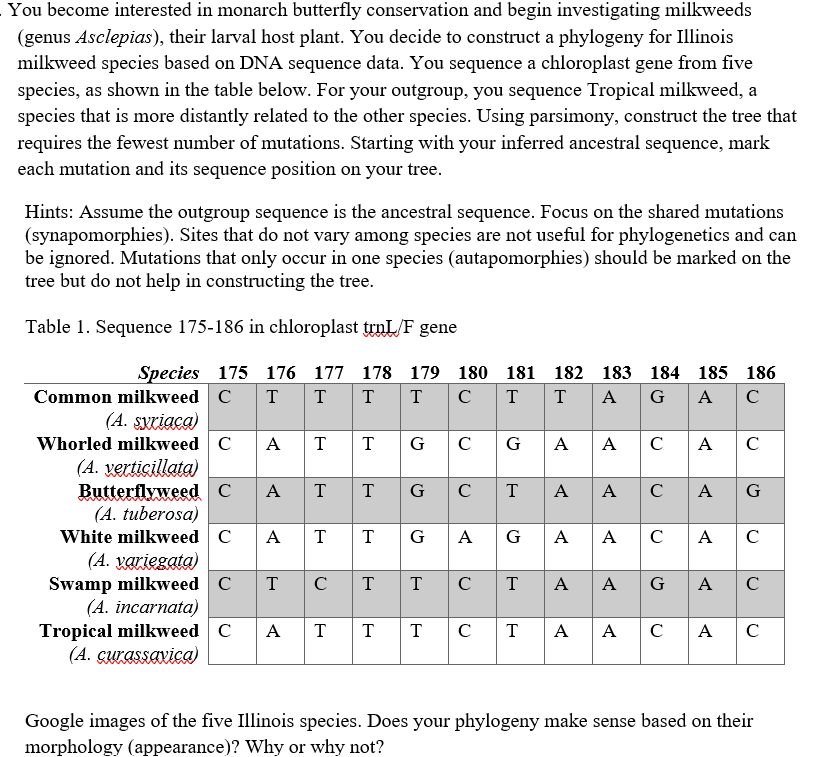You become interested in monarch butterfly conservation and begin investigating milkweeds (genus Asclepias), their larval host plant. You decide to construct a phylogeny for Illinois milkweed species based on DNA sequence data. You sequence a chloroplast gene from five species, as shown in the table below. For your outgroup, you sequence Tropical milkweed, a species that is more distantly related to the other species. Using parsimony, construct the tree that requires the fewest number of mutations. Starting with your inferred ancestral sequence, mark each mutation and its sequence position on your tree. Hints: Assume the outgroup sequence is the ancestral sequence. Focus on the shared mutations (synapomorphies). Sites that do not vary among species are not useful for phylogenetics and can be ignored. Mutations that only occur in one species (autapomorphies) should be marked on the tree but do not help in constructing the tree. Table 1. Sequence 175-186 in chloroplast trnL/F gene Species 175 176 177 178 179 180 181 182 Common milkweed C T T T T с T T A (A. syriaca) Whorled milkweed C (A. verticillata) Butterflyweed C ATT GCTA A (A. tuberosa) White milkweed C A A | T (A. variegata) Swamp milkweed C T (A. incarnata) Tropical milkweed C (A. curassavica) | T AT G C TT G A GA CT T ст T T G A C 183 184 185 186 G A с A C A C с A G A C A C CTA A G A C T A AC A C Google images of the five Illinois species. Does your phylogeny make sense based on their morphology (appearance)? Why or why not?
Evolution
The history and science of origin and evolution comprise two events, the beginning of life and expansion of life. Our earth originated about 4.5 billion years ago. The term evolution is derived from two Latin words and means the act of unfolding or unrolling. English philosopher Herbert Spencer first used it. Evolution is defined as the change in heritable traits of biological populations over successive generations. These traits are the manifestations of genes that are passed down from parent to offspring during reproduction.
Cladistics
Cladistics is a technique in the classification of organisms, where they are grouped into different clades. The proof for the relationships that are hypothesized is based on the shared derived characteristics known as synapomorphies. These characteristics do not exist in many of the distant ancestors and groups. The common ancestor along with its descendants is considered to be a part of the clade. The rate of closeness is directly proportional to the cladistic grouping and is useful in analyzing the evolutionary mechanism.
Outgroups
Outgroups are significant in studying cladistics or phylogenetics (that describe the evolutionary relationship between different organisms). Further, it is also important to understand the differences and similarities between different organisms.
Taxonomy
It is the branch of biology that works with the identification of organisms at first, then naming, and classification of them into phenetic or phylogenetic groups (a classification system). In other words, it is the scientific study of biological diversity and a part of systematic biology.
Phylogenetics
Phylogenetics is the scientific study of how various groups of organisms are related at the evolutionary level. It finds the relationship between various organisms based on their evolutionary similarities and differences. It is a part of the taxonomy. Although the taxonomic study is not only concerned about phylogeny but taxonomic studies are also concerned about the classification and nomenclature of the different individuals from different taxon.

Trending now
This is a popular solution!
Step by step
Solved in 4 steps




